Impact of Work-Life Balance on Family Life: A Literature Review
VerifiedAdded on 2021/05/31
|8
|2856
|167
Report
AI Summary
This report provides a comprehensive literature review on the critical relationship between work-life balance and its impact on family life. It explores the significance of work-life balance in modern organizations, emphasizing its effects on employee well-being, productivity, and organizational sustainability. The review examines various factors influencing work-life integration, including flexible work structures, stress management, and health initiatives. It highlights the negative consequences of poor work-life balance, such as reduced employee satisfaction, health issues, and family conflicts, while also showcasing the benefits of a healthy balance, including improved performance and stronger family relationships. The report emphasizes the importance of proactive organizational approaches, such as implementing flexible policies and promoting employee well-being programs, to enhance work-life balance and retain a skilled workforce. The analysis suggests that effective work-life balance initiatives are crucial for both employees and employers, leading to increased productivity, reduced absenteeism, and improved overall organizational performance. This research draws upon diverse perspectives from various researchers to provide a holistic understanding of the subject.
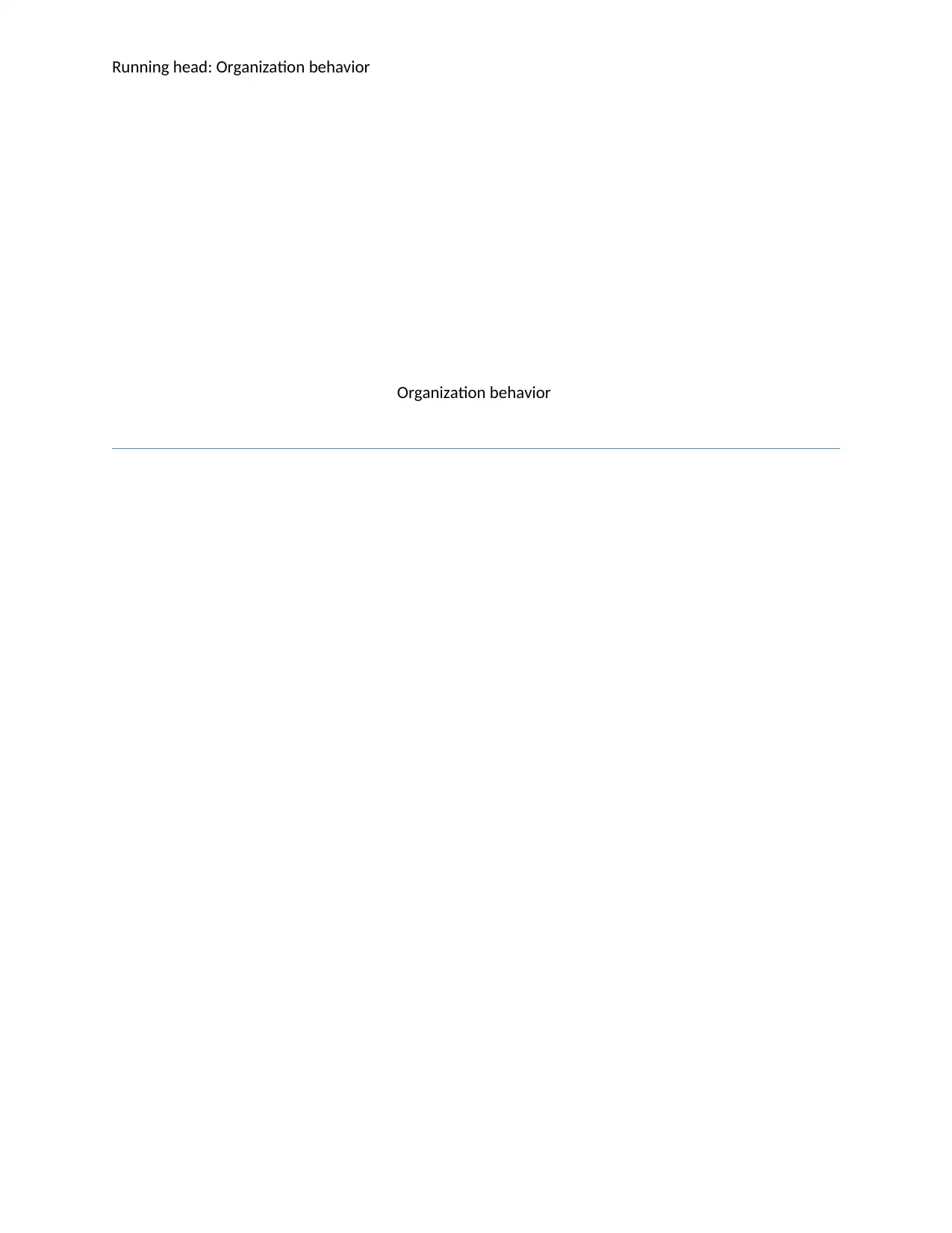
Running head: Organization behavior
Organization behavior
Organization behavior
Paraphrase This Document
Need a fresh take? Get an instant paraphrase of this document with our AI Paraphraser
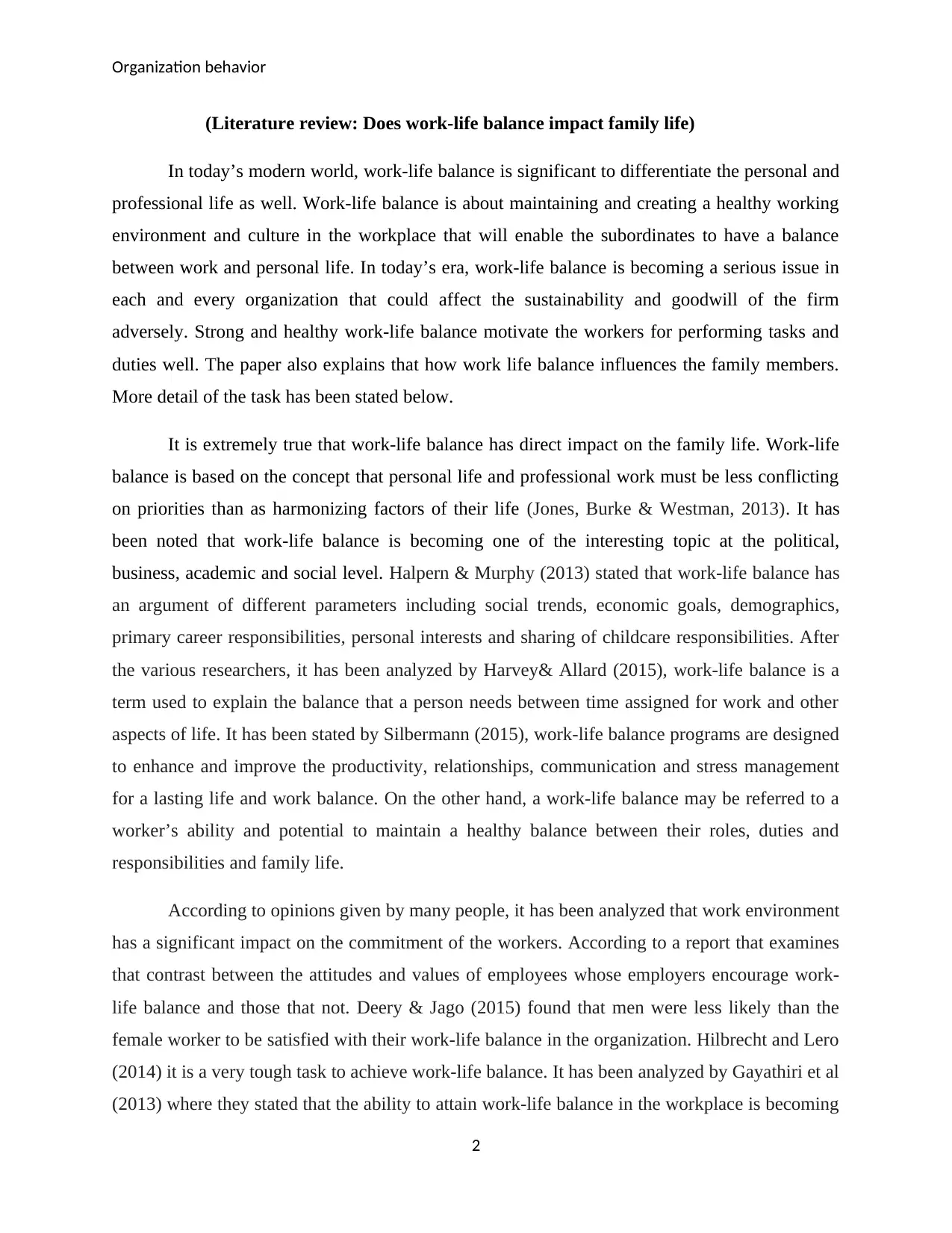
Organization behavior
(Literature review: Does work-life balance impact family life)
In today’s modern world, work-life balance is significant to differentiate the personal and
professional life as well. Work-life balance is about maintaining and creating a healthy working
environment and culture in the workplace that will enable the subordinates to have a balance
between work and personal life. In today’s era, work-life balance is becoming a serious issue in
each and every organization that could affect the sustainability and goodwill of the firm
adversely. Strong and healthy work-life balance motivate the workers for performing tasks and
duties well. The paper also explains that how work life balance influences the family members.
More detail of the task has been stated below.
It is extremely true that work-life balance has direct impact on the family life. Work-life
balance is based on the concept that personal life and professional work must be less conflicting
on priorities than as harmonizing factors of their life (Jones, Burke & Westman, 2013). It has
been noted that work-life balance is becoming one of the interesting topic at the political,
business, academic and social level. Halpern & Murphy (2013) stated that work-life balance has
an argument of different parameters including social trends, economic goals, demographics,
primary career responsibilities, personal interests and sharing of childcare responsibilities. After
the various researchers, it has been analyzed by Harvey& Allard (2015), work-life balance is a
term used to explain the balance that a person needs between time assigned for work and other
aspects of life. It has been stated by Silbermann (2015), work-life balance programs are designed
to enhance and improve the productivity, relationships, communication and stress management
for a lasting life and work balance. On the other hand, a work-life balance may be referred to a
worker’s ability and potential to maintain a healthy balance between their roles, duties and
responsibilities and family life.
According to opinions given by many people, it has been analyzed that work environment
has a significant impact on the commitment of the workers. According to a report that examines
that contrast between the attitudes and values of employees whose employers encourage work-
life balance and those that not. Deery & Jago (2015) found that men were less likely than the
female worker to be satisfied with their work-life balance in the organization. Hilbrecht and Lero
(2014) it is a very tough task to achieve work-life balance. It has been analyzed by Gayathiri et al
(2013) where they stated that the ability to attain work-life balance in the workplace is becoming
2
(Literature review: Does work-life balance impact family life)
In today’s modern world, work-life balance is significant to differentiate the personal and
professional life as well. Work-life balance is about maintaining and creating a healthy working
environment and culture in the workplace that will enable the subordinates to have a balance
between work and personal life. In today’s era, work-life balance is becoming a serious issue in
each and every organization that could affect the sustainability and goodwill of the firm
adversely. Strong and healthy work-life balance motivate the workers for performing tasks and
duties well. The paper also explains that how work life balance influences the family members.
More detail of the task has been stated below.
It is extremely true that work-life balance has direct impact on the family life. Work-life
balance is based on the concept that personal life and professional work must be less conflicting
on priorities than as harmonizing factors of their life (Jones, Burke & Westman, 2013). It has
been noted that work-life balance is becoming one of the interesting topic at the political,
business, academic and social level. Halpern & Murphy (2013) stated that work-life balance has
an argument of different parameters including social trends, economic goals, demographics,
primary career responsibilities, personal interests and sharing of childcare responsibilities. After
the various researchers, it has been analyzed by Harvey& Allard (2015), work-life balance is a
term used to explain the balance that a person needs between time assigned for work and other
aspects of life. It has been stated by Silbermann (2015), work-life balance programs are designed
to enhance and improve the productivity, relationships, communication and stress management
for a lasting life and work balance. On the other hand, a work-life balance may be referred to a
worker’s ability and potential to maintain a healthy balance between their roles, duties and
responsibilities and family life.
According to opinions given by many people, it has been analyzed that work environment
has a significant impact on the commitment of the workers. According to a report that examines
that contrast between the attitudes and values of employees whose employers encourage work-
life balance and those that not. Deery & Jago (2015) found that men were less likely than the
female worker to be satisfied with their work-life balance in the organization. Hilbrecht and Lero
(2014) it is a very tough task to achieve work-life balance. It has been analyzed by Gayathiri et al
(2013) where they stated that the ability to attain work-life balance in the workplace is becoming
2
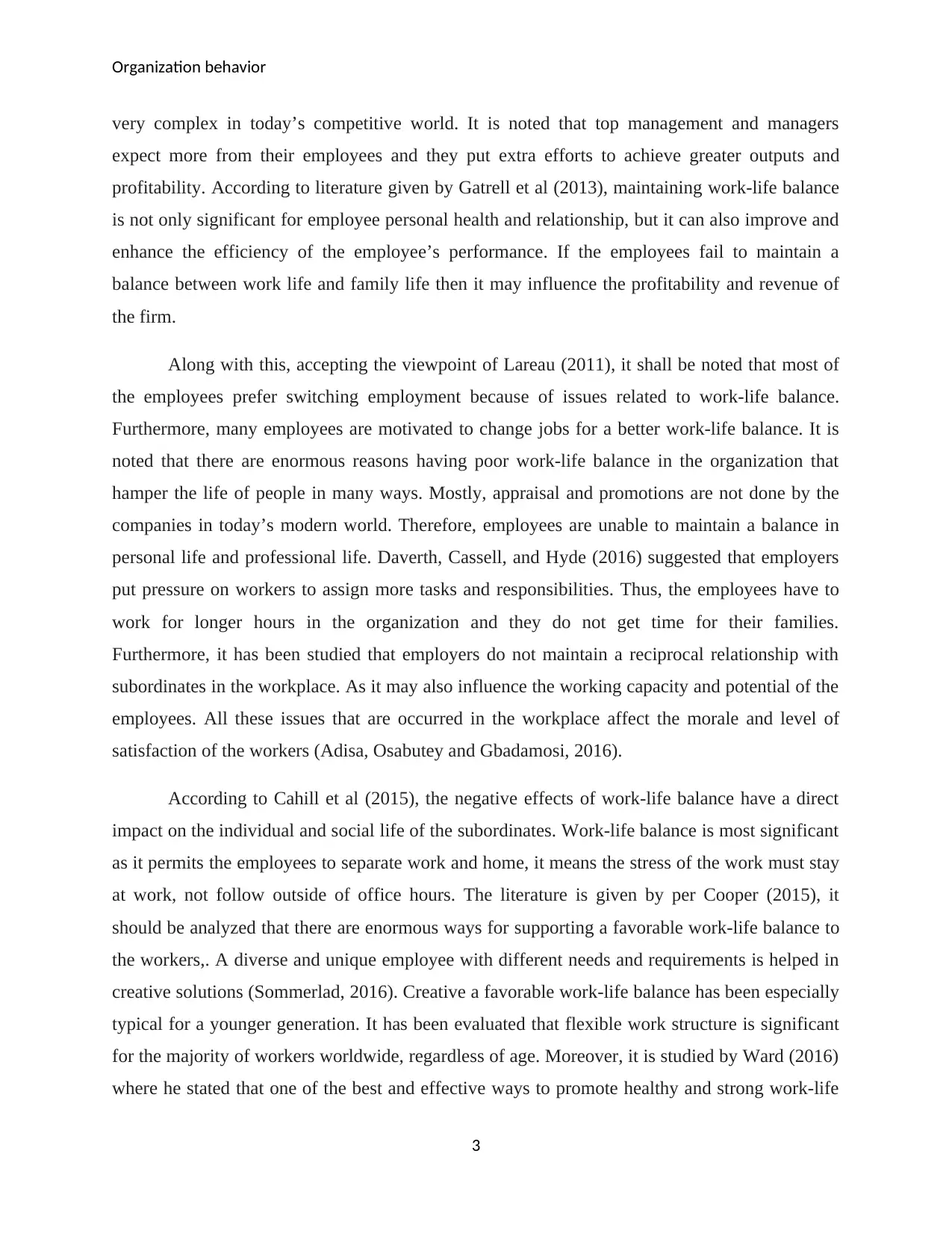
Organization behavior
very complex in today’s competitive world. It is noted that top management and managers
expect more from their employees and they put extra efforts to achieve greater outputs and
profitability. According to literature given by Gatrell et al (2013), maintaining work-life balance
is not only significant for employee personal health and relationship, but it can also improve and
enhance the efficiency of the employee’s performance. If the employees fail to maintain a
balance between work life and family life then it may influence the profitability and revenue of
the firm.
Along with this, accepting the viewpoint of Lareau (2011), it shall be noted that most of
the employees prefer switching employment because of issues related to work-life balance.
Furthermore, many employees are motivated to change jobs for a better work-life balance. It is
noted that there are enormous reasons having poor work-life balance in the organization that
hamper the life of people in many ways. Mostly, appraisal and promotions are not done by the
companies in today’s modern world. Therefore, employees are unable to maintain a balance in
personal life and professional life. Daverth, Cassell, and Hyde (2016) suggested that employers
put pressure on workers to assign more tasks and responsibilities. Thus, the employees have to
work for longer hours in the organization and they do not get time for their families.
Furthermore, it has been studied that employers do not maintain a reciprocal relationship with
subordinates in the workplace. As it may also influence the working capacity and potential of the
employees. All these issues that are occurred in the workplace affect the morale and level of
satisfaction of the workers (Adisa, Osabutey and Gbadamosi, 2016).
According to Cahill et al (2015), the negative effects of work-life balance have a direct
impact on the individual and social life of the subordinates. Work-life balance is most significant
as it permits the employees to separate work and home, it means the stress of the work must stay
at work, not follow outside of office hours. The literature is given by per Cooper (2015), it
should be analyzed that there are enormous ways for supporting a favorable work-life balance to
the workers,. A diverse and unique employee with different needs and requirements is helped in
creative solutions (Sommerlad, 2016). Creative a favorable work-life balance has been especially
typical for a younger generation. It has been evaluated that flexible work structure is significant
for the majority of workers worldwide, regardless of age. Moreover, it is studied by Ward (2016)
where he stated that one of the best and effective ways to promote healthy and strong work-life
3
very complex in today’s competitive world. It is noted that top management and managers
expect more from their employees and they put extra efforts to achieve greater outputs and
profitability. According to literature given by Gatrell et al (2013), maintaining work-life balance
is not only significant for employee personal health and relationship, but it can also improve and
enhance the efficiency of the employee’s performance. If the employees fail to maintain a
balance between work life and family life then it may influence the profitability and revenue of
the firm.
Along with this, accepting the viewpoint of Lareau (2011), it shall be noted that most of
the employees prefer switching employment because of issues related to work-life balance.
Furthermore, many employees are motivated to change jobs for a better work-life balance. It is
noted that there are enormous reasons having poor work-life balance in the organization that
hamper the life of people in many ways. Mostly, appraisal and promotions are not done by the
companies in today’s modern world. Therefore, employees are unable to maintain a balance in
personal life and professional life. Daverth, Cassell, and Hyde (2016) suggested that employers
put pressure on workers to assign more tasks and responsibilities. Thus, the employees have to
work for longer hours in the organization and they do not get time for their families.
Furthermore, it has been studied that employers do not maintain a reciprocal relationship with
subordinates in the workplace. As it may also influence the working capacity and potential of the
employees. All these issues that are occurred in the workplace affect the morale and level of
satisfaction of the workers (Adisa, Osabutey and Gbadamosi, 2016).
According to Cahill et al (2015), the negative effects of work-life balance have a direct
impact on the individual and social life of the subordinates. Work-life balance is most significant
as it permits the employees to separate work and home, it means the stress of the work must stay
at work, not follow outside of office hours. The literature is given by per Cooper (2015), it
should be analyzed that there are enormous ways for supporting a favorable work-life balance to
the workers,. A diverse and unique employee with different needs and requirements is helped in
creative solutions (Sommerlad, 2016). Creative a favorable work-life balance has been especially
typical for a younger generation. It has been evaluated that flexible work structure is significant
for the majority of workers worldwide, regardless of age. Moreover, it is studied by Ward (2016)
where he stated that one of the best and effective ways to promote healthy and strong work-life
3
⊘ This is a preview!⊘
Do you want full access?
Subscribe today to unlock all pages.

Trusted by 1+ million students worldwide
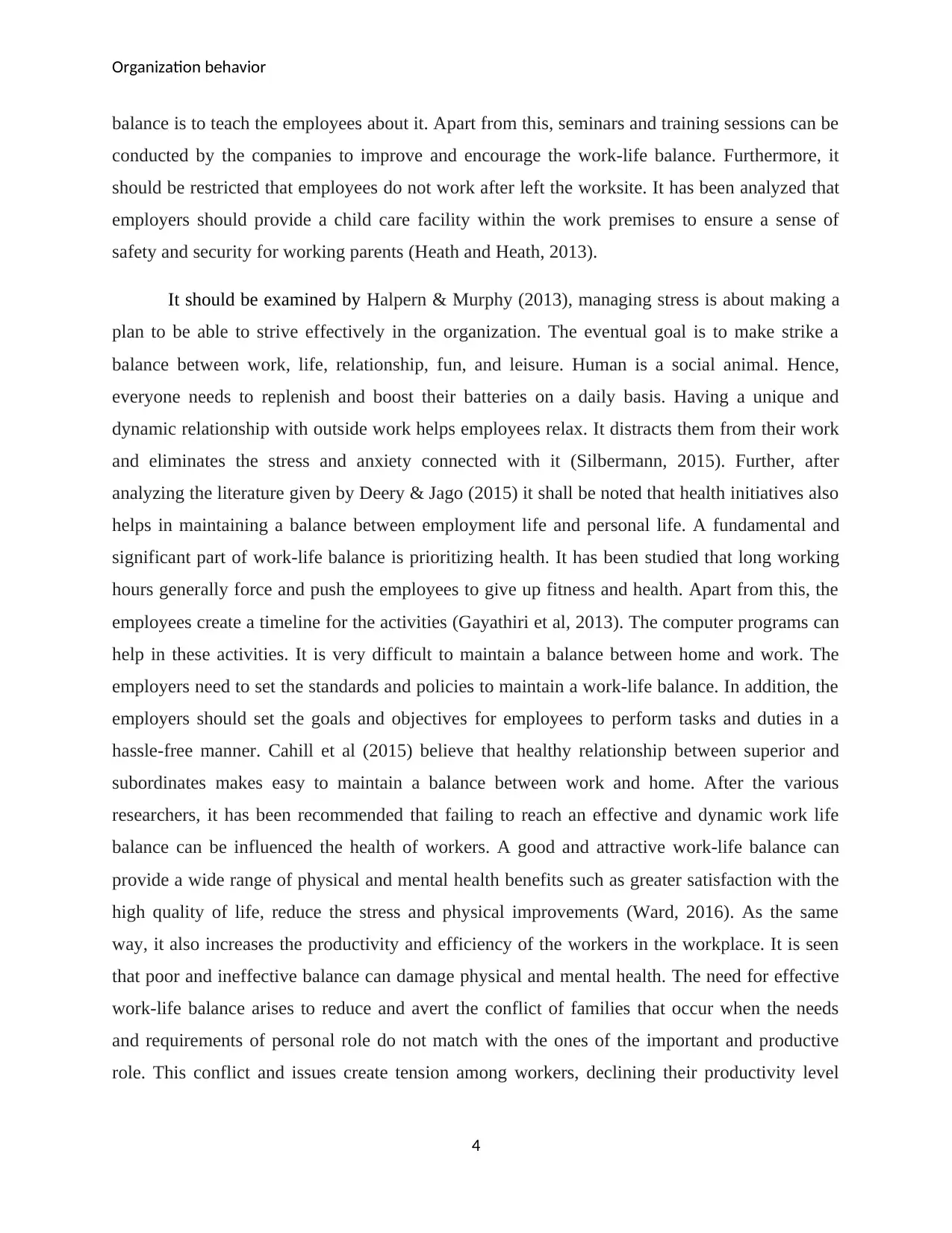
Organization behavior
balance is to teach the employees about it. Apart from this, seminars and training sessions can be
conducted by the companies to improve and encourage the work-life balance. Furthermore, it
should be restricted that employees do not work after left the worksite. It has been analyzed that
employers should provide a child care facility within the work premises to ensure a sense of
safety and security for working parents (Heath and Heath, 2013).
It should be examined by Halpern & Murphy (2013), managing stress is about making a
plan to be able to strive effectively in the organization. The eventual goal is to make strike a
balance between work, life, relationship, fun, and leisure. Human is a social animal. Hence,
everyone needs to replenish and boost their batteries on a daily basis. Having a unique and
dynamic relationship with outside work helps employees relax. It distracts them from their work
and eliminates the stress and anxiety connected with it (Silbermann, 2015). Further, after
analyzing the literature given by Deery & Jago (2015) it shall be noted that health initiatives also
helps in maintaining a balance between employment life and personal life. A fundamental and
significant part of work-life balance is prioritizing health. It has been studied that long working
hours generally force and push the employees to give up fitness and health. Apart from this, the
employees create a timeline for the activities (Gayathiri et al, 2013). The computer programs can
help in these activities. It is very difficult to maintain a balance between home and work. The
employers need to set the standards and policies to maintain a work-life balance. In addition, the
employers should set the goals and objectives for employees to perform tasks and duties in a
hassle-free manner. Cahill et al (2015) believe that healthy relationship between superior and
subordinates makes easy to maintain a balance between work and home. After the various
researchers, it has been recommended that failing to reach an effective and dynamic work life
balance can be influenced the health of workers. A good and attractive work-life balance can
provide a wide range of physical and mental health benefits such as greater satisfaction with the
high quality of life, reduce the stress and physical improvements (Ward, 2016). As the same
way, it also increases the productivity and efficiency of the workers in the workplace. It is seen
that poor and ineffective balance can damage physical and mental health. The need for effective
work-life balance arises to reduce and avert the conflict of families that occur when the needs
and requirements of personal role do not match with the ones of the important and productive
role. This conflict and issues create tension among workers, declining their productivity level
4
balance is to teach the employees about it. Apart from this, seminars and training sessions can be
conducted by the companies to improve and encourage the work-life balance. Furthermore, it
should be restricted that employees do not work after left the worksite. It has been analyzed that
employers should provide a child care facility within the work premises to ensure a sense of
safety and security for working parents (Heath and Heath, 2013).
It should be examined by Halpern & Murphy (2013), managing stress is about making a
plan to be able to strive effectively in the organization. The eventual goal is to make strike a
balance between work, life, relationship, fun, and leisure. Human is a social animal. Hence,
everyone needs to replenish and boost their batteries on a daily basis. Having a unique and
dynamic relationship with outside work helps employees relax. It distracts them from their work
and eliminates the stress and anxiety connected with it (Silbermann, 2015). Further, after
analyzing the literature given by Deery & Jago (2015) it shall be noted that health initiatives also
helps in maintaining a balance between employment life and personal life. A fundamental and
significant part of work-life balance is prioritizing health. It has been studied that long working
hours generally force and push the employees to give up fitness and health. Apart from this, the
employees create a timeline for the activities (Gayathiri et al, 2013). The computer programs can
help in these activities. It is very difficult to maintain a balance between home and work. The
employers need to set the standards and policies to maintain a work-life balance. In addition, the
employers should set the goals and objectives for employees to perform tasks and duties in a
hassle-free manner. Cahill et al (2015) believe that healthy relationship between superior and
subordinates makes easy to maintain a balance between work and home. After the various
researchers, it has been recommended that failing to reach an effective and dynamic work life
balance can be influenced the health of workers. A good and attractive work-life balance can
provide a wide range of physical and mental health benefits such as greater satisfaction with the
high quality of life, reduce the stress and physical improvements (Ward, 2016). As the same
way, it also increases the productivity and efficiency of the workers in the workplace. It is seen
that poor and ineffective balance can damage physical and mental health. The need for effective
work-life balance arises to reduce and avert the conflict of families that occur when the needs
and requirements of personal role do not match with the ones of the important and productive
role. This conflict and issues create tension among workers, declining their productivity level
4
Paraphrase This Document
Need a fresh take? Get an instant paraphrase of this document with our AI Paraphraser
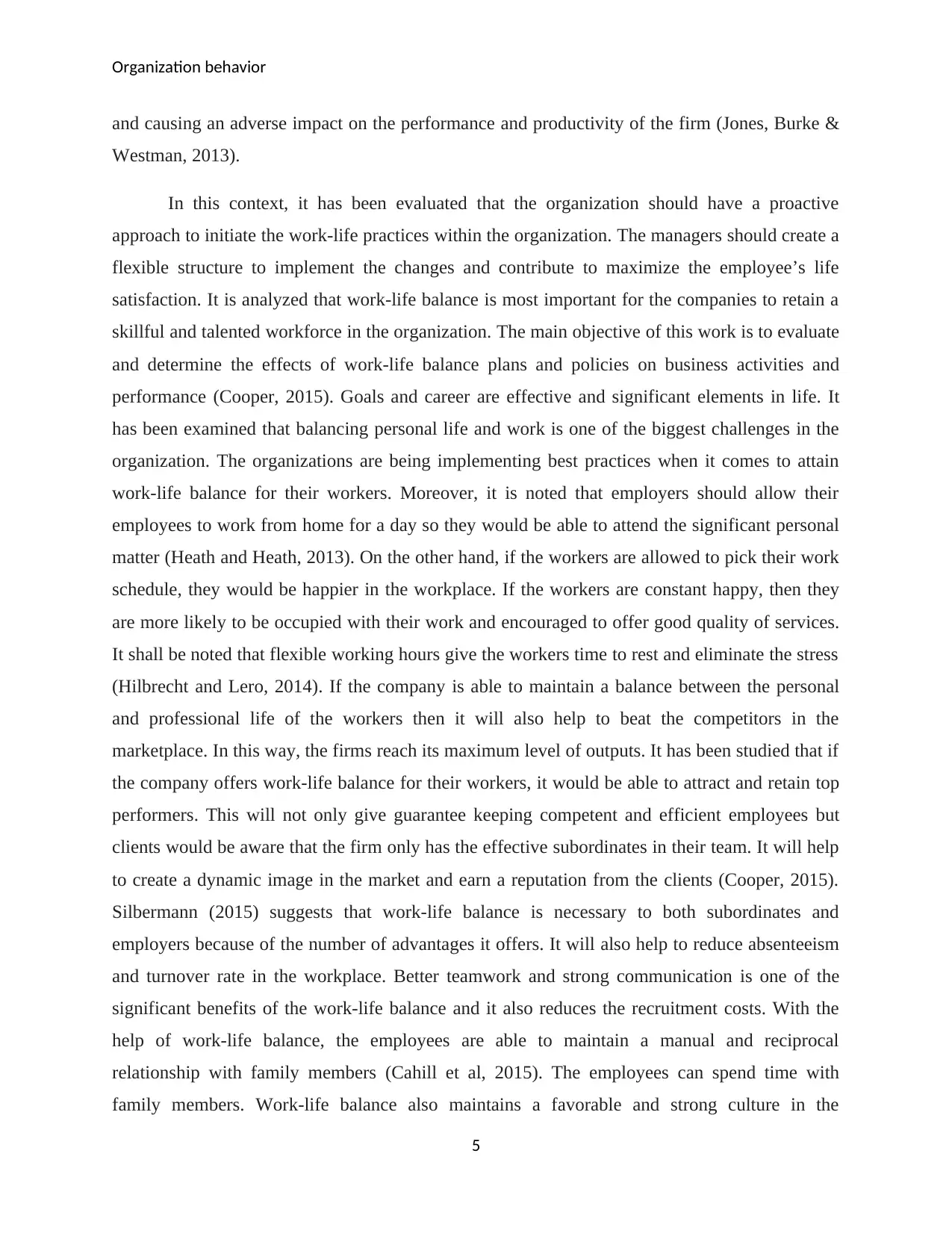
Organization behavior
and causing an adverse impact on the performance and productivity of the firm (Jones, Burke &
Westman, 2013).
In this context, it has been evaluated that the organization should have a proactive
approach to initiate the work-life practices within the organization. The managers should create a
flexible structure to implement the changes and contribute to maximize the employee’s life
satisfaction. It is analyzed that work-life balance is most important for the companies to retain a
skillful and talented workforce in the organization. The main objective of this work is to evaluate
and determine the effects of work-life balance plans and policies on business activities and
performance (Cooper, 2015). Goals and career are effective and significant elements in life. It
has been examined that balancing personal life and work is one of the biggest challenges in the
organization. The organizations are being implementing best practices when it comes to attain
work-life balance for their workers. Moreover, it is noted that employers should allow their
employees to work from home for a day so they would be able to attend the significant personal
matter (Heath and Heath, 2013). On the other hand, if the workers are allowed to pick their work
schedule, they would be happier in the workplace. If the workers are constant happy, then they
are more likely to be occupied with their work and encouraged to offer good quality of services.
It shall be noted that flexible working hours give the workers time to rest and eliminate the stress
(Hilbrecht and Lero, 2014). If the company is able to maintain a balance between the personal
and professional life of the workers then it will also help to beat the competitors in the
marketplace. In this way, the firms reach its maximum level of outputs. It has been studied that if
the company offers work-life balance for their workers, it would be able to attract and retain top
performers. This will not only give guarantee keeping competent and efficient employees but
clients would be aware that the firm only has the effective subordinates in their team. It will help
to create a dynamic image in the market and earn a reputation from the clients (Cooper, 2015).
Silbermann (2015) suggests that work-life balance is necessary to both subordinates and
employers because of the number of advantages it offers. It will also help to reduce absenteeism
and turnover rate in the workplace. Better teamwork and strong communication is one of the
significant benefits of the work-life balance and it also reduces the recruitment costs. With the
help of work-life balance, the employees are able to maintain a manual and reciprocal
relationship with family members (Cahill et al, 2015). The employees can spend time with
family members. Work-life balance also maintains a favorable and strong culture in the
5
and causing an adverse impact on the performance and productivity of the firm (Jones, Burke &
Westman, 2013).
In this context, it has been evaluated that the organization should have a proactive
approach to initiate the work-life practices within the organization. The managers should create a
flexible structure to implement the changes and contribute to maximize the employee’s life
satisfaction. It is analyzed that work-life balance is most important for the companies to retain a
skillful and talented workforce in the organization. The main objective of this work is to evaluate
and determine the effects of work-life balance plans and policies on business activities and
performance (Cooper, 2015). Goals and career are effective and significant elements in life. It
has been examined that balancing personal life and work is one of the biggest challenges in the
organization. The organizations are being implementing best practices when it comes to attain
work-life balance for their workers. Moreover, it is noted that employers should allow their
employees to work from home for a day so they would be able to attend the significant personal
matter (Heath and Heath, 2013). On the other hand, if the workers are allowed to pick their work
schedule, they would be happier in the workplace. If the workers are constant happy, then they
are more likely to be occupied with their work and encouraged to offer good quality of services.
It shall be noted that flexible working hours give the workers time to rest and eliminate the stress
(Hilbrecht and Lero, 2014). If the company is able to maintain a balance between the personal
and professional life of the workers then it will also help to beat the competitors in the
marketplace. In this way, the firms reach its maximum level of outputs. It has been studied that if
the company offers work-life balance for their workers, it would be able to attract and retain top
performers. This will not only give guarantee keeping competent and efficient employees but
clients would be aware that the firm only has the effective subordinates in their team. It will help
to create a dynamic image in the market and earn a reputation from the clients (Cooper, 2015).
Silbermann (2015) suggests that work-life balance is necessary to both subordinates and
employers because of the number of advantages it offers. It will also help to reduce absenteeism
and turnover rate in the workplace. Better teamwork and strong communication is one of the
significant benefits of the work-life balance and it also reduces the recruitment costs. With the
help of work-life balance, the employees are able to maintain a manual and reciprocal
relationship with family members (Cahill et al, 2015). The employees can spend time with
family members. Work-life balance also maintains a favorable and strong culture in the
5
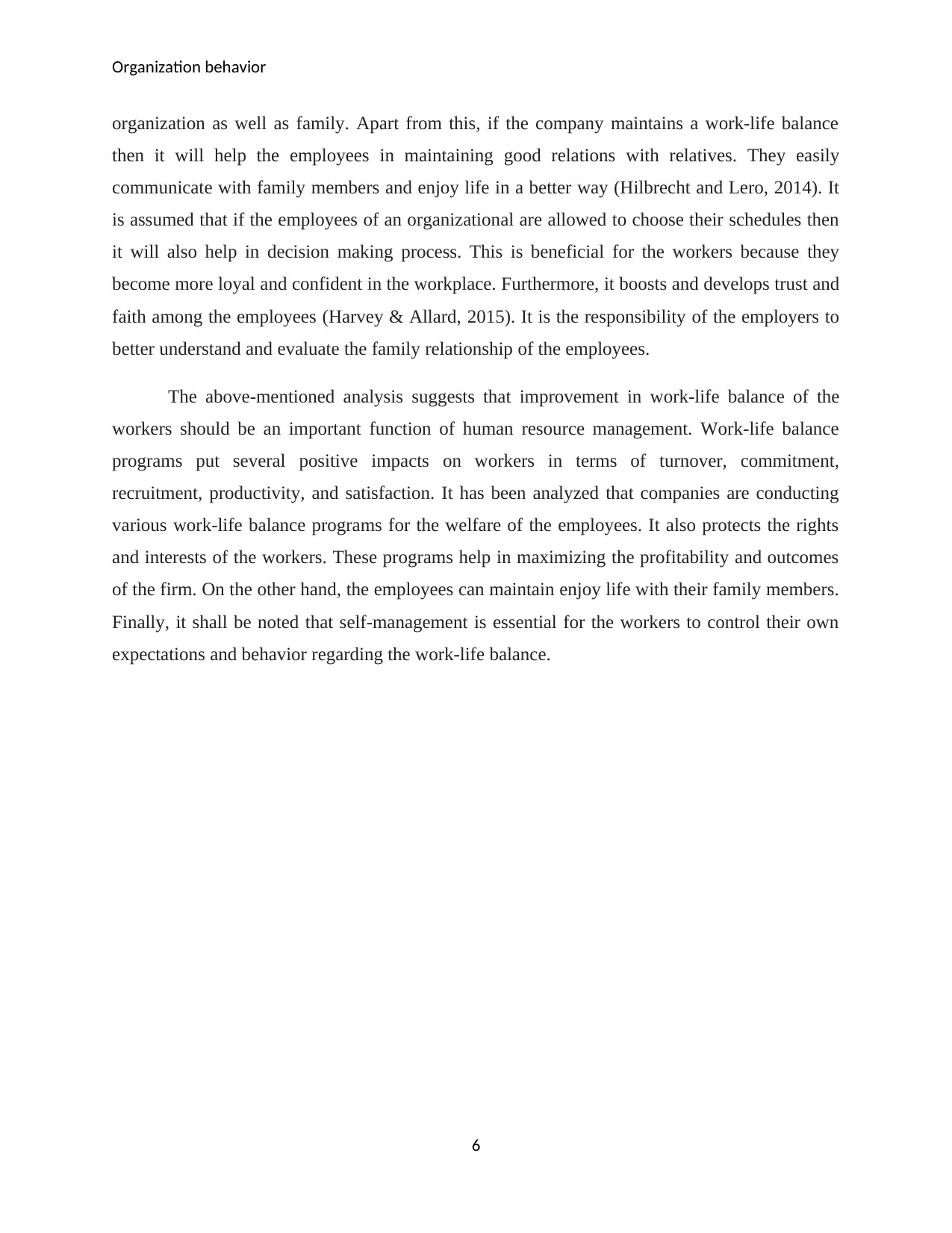
Organization behavior
organization as well as family. Apart from this, if the company maintains a work-life balance
then it will help the employees in maintaining good relations with relatives. They easily
communicate with family members and enjoy life in a better way (Hilbrecht and Lero, 2014). It
is assumed that if the employees of an organizational are allowed to choose their schedules then
it will also help in decision making process. This is beneficial for the workers because they
become more loyal and confident in the workplace. Furthermore, it boosts and develops trust and
faith among the employees (Harvey & Allard, 2015). It is the responsibility of the employers to
better understand and evaluate the family relationship of the employees.
The above-mentioned analysis suggests that improvement in work-life balance of the
workers should be an important function of human resource management. Work-life balance
programs put several positive impacts on workers in terms of turnover, commitment,
recruitment, productivity, and satisfaction. It has been analyzed that companies are conducting
various work-life balance programs for the welfare of the employees. It also protects the rights
and interests of the workers. These programs help in maximizing the profitability and outcomes
of the firm. On the other hand, the employees can maintain enjoy life with their family members.
Finally, it shall be noted that self-management is essential for the workers to control their own
expectations and behavior regarding the work-life balance.
6
organization as well as family. Apart from this, if the company maintains a work-life balance
then it will help the employees in maintaining good relations with relatives. They easily
communicate with family members and enjoy life in a better way (Hilbrecht and Lero, 2014). It
is assumed that if the employees of an organizational are allowed to choose their schedules then
it will also help in decision making process. This is beneficial for the workers because they
become more loyal and confident in the workplace. Furthermore, it boosts and develops trust and
faith among the employees (Harvey & Allard, 2015). It is the responsibility of the employers to
better understand and evaluate the family relationship of the employees.
The above-mentioned analysis suggests that improvement in work-life balance of the
workers should be an important function of human resource management. Work-life balance
programs put several positive impacts on workers in terms of turnover, commitment,
recruitment, productivity, and satisfaction. It has been analyzed that companies are conducting
various work-life balance programs for the welfare of the employees. It also protects the rights
and interests of the workers. These programs help in maximizing the profitability and outcomes
of the firm. On the other hand, the employees can maintain enjoy life with their family members.
Finally, it shall be noted that self-management is essential for the workers to control their own
expectations and behavior regarding the work-life balance.
6
⊘ This is a preview!⊘
Do you want full access?
Subscribe today to unlock all pages.

Trusted by 1+ million students worldwide
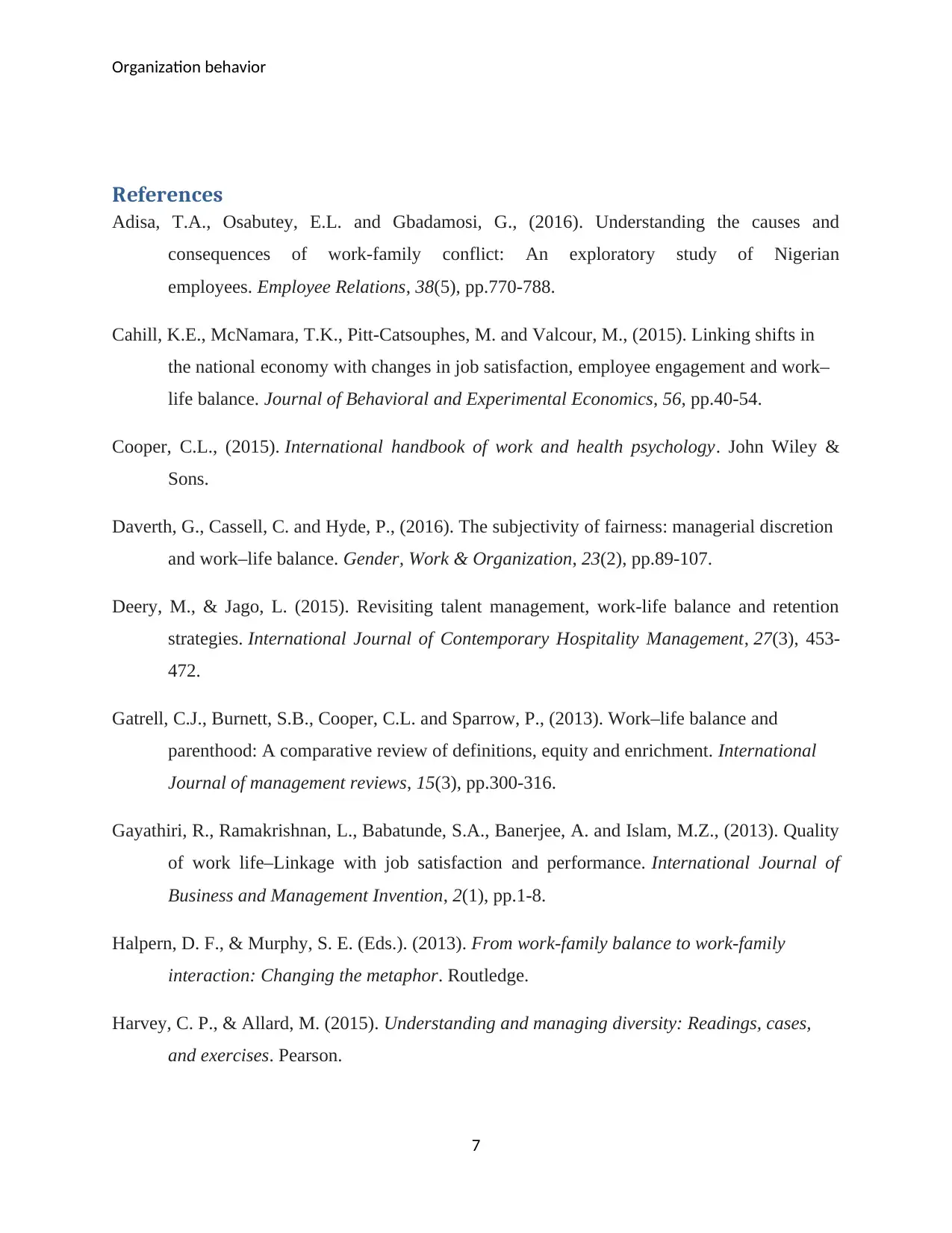
Organization behavior
References
Adisa, T.A., Osabutey, E.L. and Gbadamosi, G., (2016). Understanding the causes and
consequences of work-family conflict: An exploratory study of Nigerian
employees. Employee Relations, 38(5), pp.770-788.
Cahill, K.E., McNamara, T.K., Pitt-Catsouphes, M. and Valcour, M., (2015). Linking shifts in
the national economy with changes in job satisfaction, employee engagement and work–
life balance. Journal of Behavioral and Experimental Economics, 56, pp.40-54.
Cooper, C.L., (2015). International handbook of work and health psychology. John Wiley &
Sons.
Daverth, G., Cassell, C. and Hyde, P., (2016). The subjectivity of fairness: managerial discretion
and work–life balance. Gender, Work & Organization, 23(2), pp.89-107.
Deery, M., & Jago, L. (2015). Revisiting talent management, work-life balance and retention
strategies. International Journal of Contemporary Hospitality Management, 27(3), 453-
472.
Gatrell, C.J., Burnett, S.B., Cooper, C.L. and Sparrow, P., (2013). Work–life balance and
parenthood: A comparative review of definitions, equity and enrichment. International
Journal of management reviews, 15(3), pp.300-316.
Gayathiri, R., Ramakrishnan, L., Babatunde, S.A., Banerjee, A. and Islam, M.Z., (2013). Quality
of work life–Linkage with job satisfaction and performance. International Journal of
Business and Management Invention, 2(1), pp.1-8.
Halpern, D. F., & Murphy, S. E. (Eds.). (2013). From work-family balance to work-family
interaction: Changing the metaphor. Routledge.
Harvey, C. P., & Allard, M. (2015). Understanding and managing diversity: Readings, cases,
and exercises. Pearson.
7
References
Adisa, T.A., Osabutey, E.L. and Gbadamosi, G., (2016). Understanding the causes and
consequences of work-family conflict: An exploratory study of Nigerian
employees. Employee Relations, 38(5), pp.770-788.
Cahill, K.E., McNamara, T.K., Pitt-Catsouphes, M. and Valcour, M., (2015). Linking shifts in
the national economy with changes in job satisfaction, employee engagement and work–
life balance. Journal of Behavioral and Experimental Economics, 56, pp.40-54.
Cooper, C.L., (2015). International handbook of work and health psychology. John Wiley &
Sons.
Daverth, G., Cassell, C. and Hyde, P., (2016). The subjectivity of fairness: managerial discretion
and work–life balance. Gender, Work & Organization, 23(2), pp.89-107.
Deery, M., & Jago, L. (2015). Revisiting talent management, work-life balance and retention
strategies. International Journal of Contemporary Hospitality Management, 27(3), 453-
472.
Gatrell, C.J., Burnett, S.B., Cooper, C.L. and Sparrow, P., (2013). Work–life balance and
parenthood: A comparative review of definitions, equity and enrichment. International
Journal of management reviews, 15(3), pp.300-316.
Gayathiri, R., Ramakrishnan, L., Babatunde, S.A., Banerjee, A. and Islam, M.Z., (2013). Quality
of work life–Linkage with job satisfaction and performance. International Journal of
Business and Management Invention, 2(1), pp.1-8.
Halpern, D. F., & Murphy, S. E. (Eds.). (2013). From work-family balance to work-family
interaction: Changing the metaphor. Routledge.
Harvey, C. P., & Allard, M. (2015). Understanding and managing diversity: Readings, cases,
and exercises. Pearson.
7
Paraphrase This Document
Need a fresh take? Get an instant paraphrase of this document with our AI Paraphraser
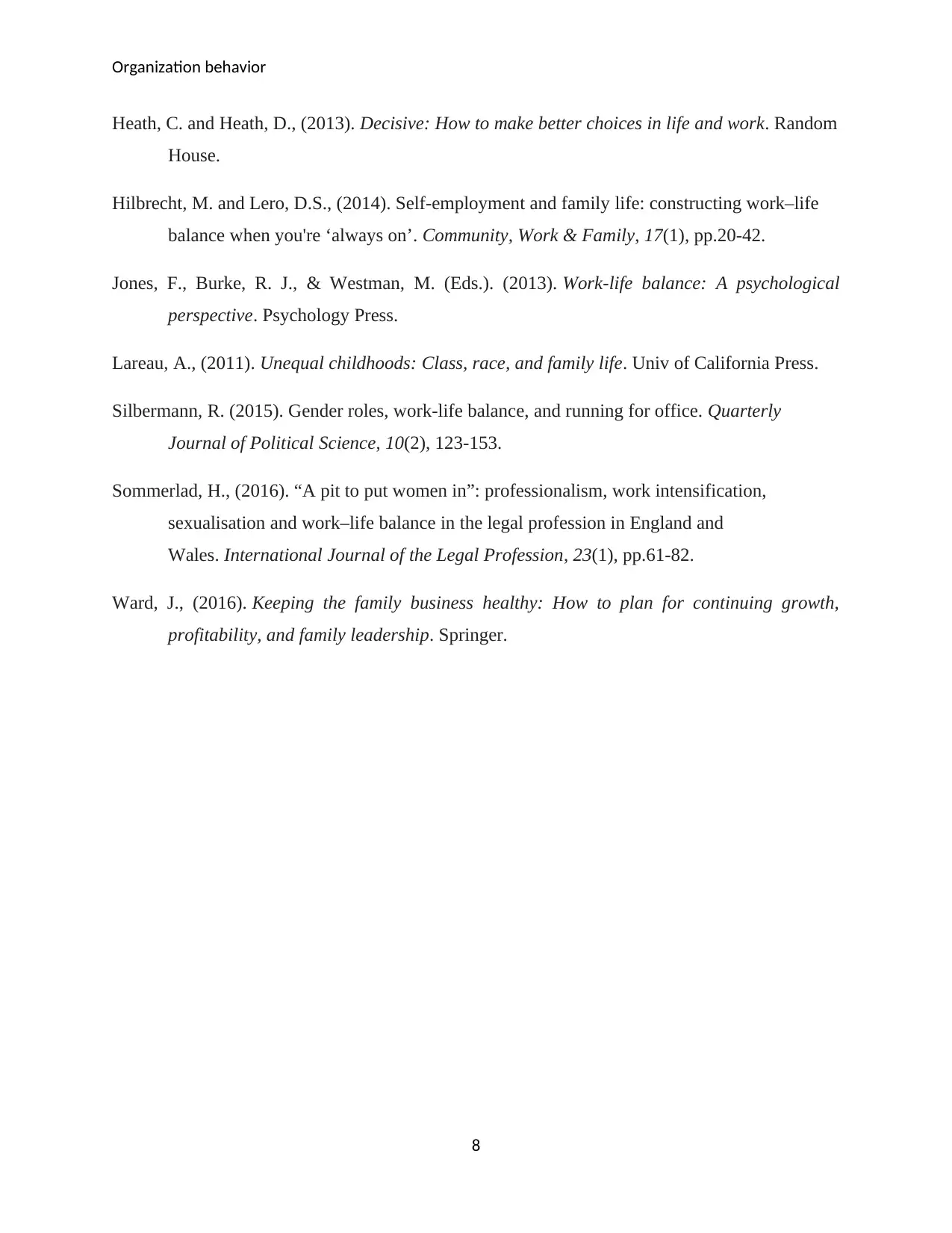
Organization behavior
Heath, C. and Heath, D., (2013). Decisive: How to make better choices in life and work. Random
House.
Hilbrecht, M. and Lero, D.S., (2014). Self-employment and family life: constructing work–life
balance when you're ‘always on’. Community, Work & Family, 17(1), pp.20-42.
Jones, F., Burke, R. J., & Westman, M. (Eds.). (2013). Work-life balance: A psychological
perspective. Psychology Press.
Lareau, A., (2011). Unequal childhoods: Class, race, and family life. Univ of California Press.
Silbermann, R. (2015). Gender roles, work-life balance, and running for office. Quarterly
Journal of Political Science, 10(2), 123-153.
Sommerlad, H., (2016). “A pit to put women in”: professionalism, work intensification,
sexualisation and work–life balance in the legal profession in England and
Wales. International Journal of the Legal Profession, 23(1), pp.61-82.
Ward, J., (2016). Keeping the family business healthy: How to plan for continuing growth,
profitability, and family leadership. Springer.
8
Heath, C. and Heath, D., (2013). Decisive: How to make better choices in life and work. Random
House.
Hilbrecht, M. and Lero, D.S., (2014). Self-employment and family life: constructing work–life
balance when you're ‘always on’. Community, Work & Family, 17(1), pp.20-42.
Jones, F., Burke, R. J., & Westman, M. (Eds.). (2013). Work-life balance: A psychological
perspective. Psychology Press.
Lareau, A., (2011). Unequal childhoods: Class, race, and family life. Univ of California Press.
Silbermann, R. (2015). Gender roles, work-life balance, and running for office. Quarterly
Journal of Political Science, 10(2), 123-153.
Sommerlad, H., (2016). “A pit to put women in”: professionalism, work intensification,
sexualisation and work–life balance in the legal profession in England and
Wales. International Journal of the Legal Profession, 23(1), pp.61-82.
Ward, J., (2016). Keeping the family business healthy: How to plan for continuing growth,
profitability, and family leadership. Springer.
8
1 out of 8
Related Documents
Your All-in-One AI-Powered Toolkit for Academic Success.
+13062052269
info@desklib.com
Available 24*7 on WhatsApp / Email
![[object Object]](/_next/static/media/star-bottom.7253800d.svg)
Unlock your academic potential
Copyright © 2020–2025 A2Z Services. All Rights Reserved. Developed and managed by ZUCOL.





